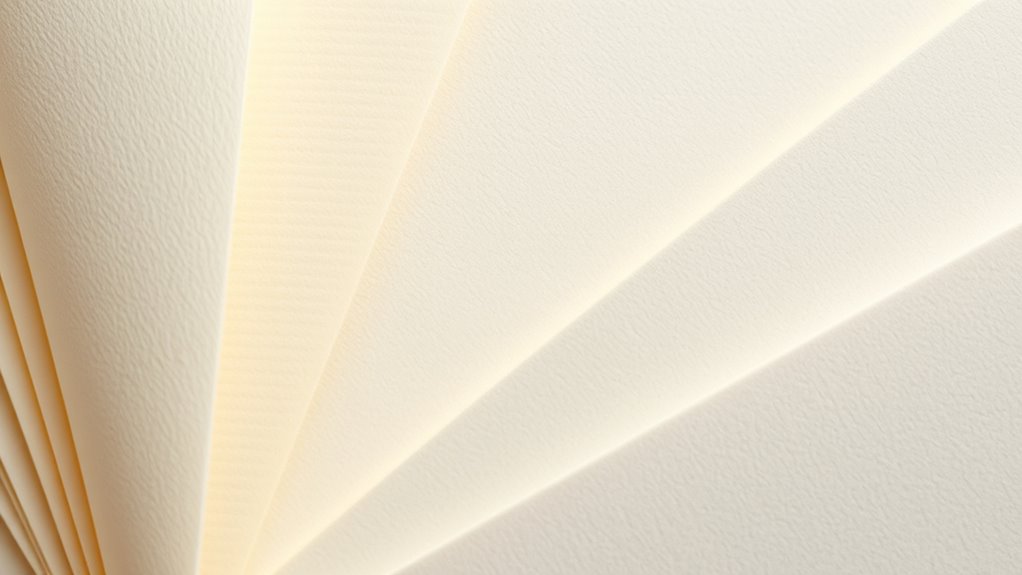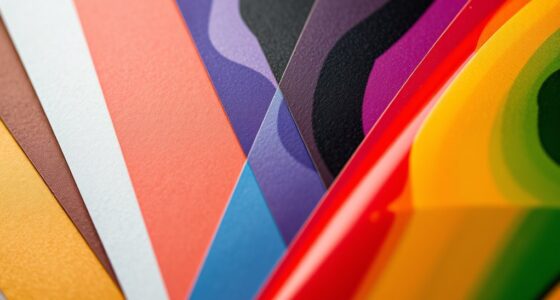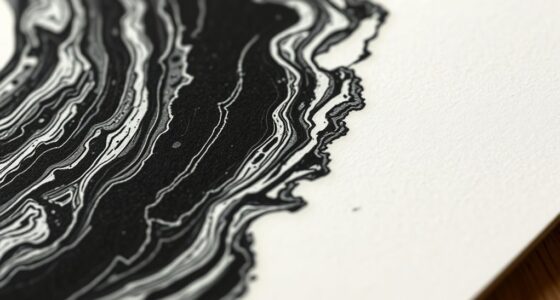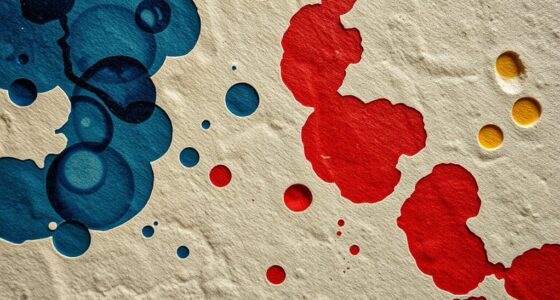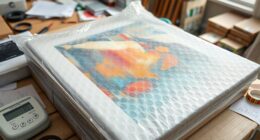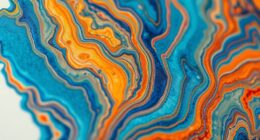The science of paper weight and texture involves understanding how measurements like grams per square meter (gsm) and basis weight determine durability and feel. Fiber type, density, and thickness influence surface texture, from smooth to rough, while manufacturing processes and surface coatings further shape the final touch and appearance. Lighter papers feel delicate and airy, while heavier ones offer a sturdy, premium feel. To explore how these factors work together, keep going to uncover more insights.
Key Takeaways
- Paper weight is measured in grams per square meter (gsm) or basis weight, affecting durability and feel.
- Fiber types, such as long or short fibers, influence the density, weight, and texture of the paper.
- Manufacturing processes like calendering and coating modify surface smoothness, texture, and visual qualities.
- Thicker and denser papers feel more substantial and are suited for high-end applications, while lighter papers are more delicate.
- Surface treatments, including embossing and matte coatings, further alter tactile experience and appearance.
Understanding Paper Weight: Measurement Units and Standards
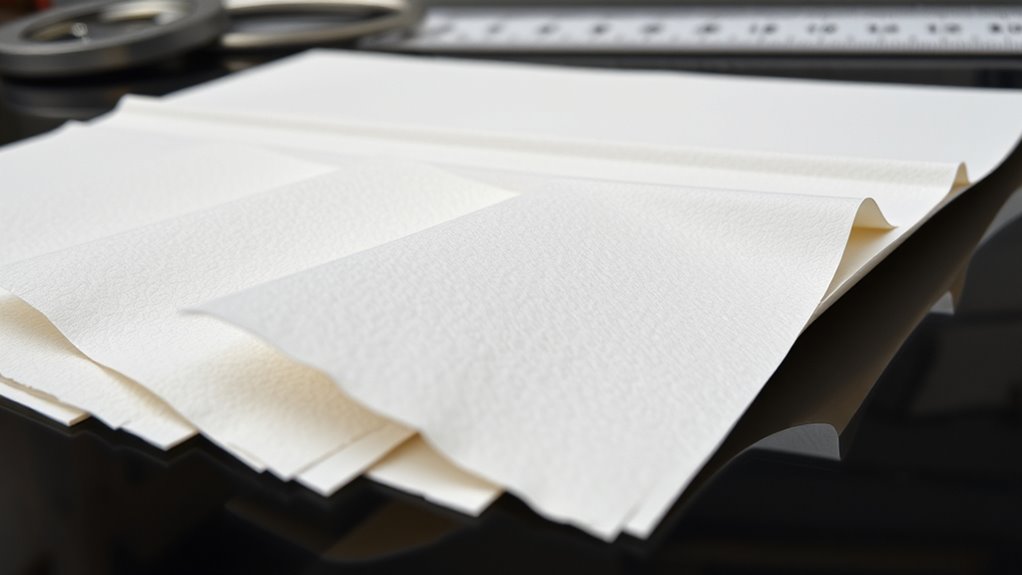
Understanding paper weight begins with knowing how it’s measured and the standards that define it. Typically, paper weight is expressed in grams per square meter (gsm) or by basis weight, which varies depending on the paper size and type. Eco friendly materials are often used to produce lightweight papers without sacrificing strength, making them more sustainable. For archival quality paper, weight is essential because it indicates durability and longevity, ensuring documents last over time. Heavier papers tend to be more resistant to wear and tear, ideal for preservation. Standards set by organizations like the ISO help maintain consistency across manufacturers, so you can compare weights accurately. Additionally, paper texture can influence how the material feels and performs in various applications. Whether you’re choosing eco friendly options or archival quality paper, understanding these measurement systems helps you select the right paper for your needs.
The Composition of Paper Fibers and Its Impact on Weight
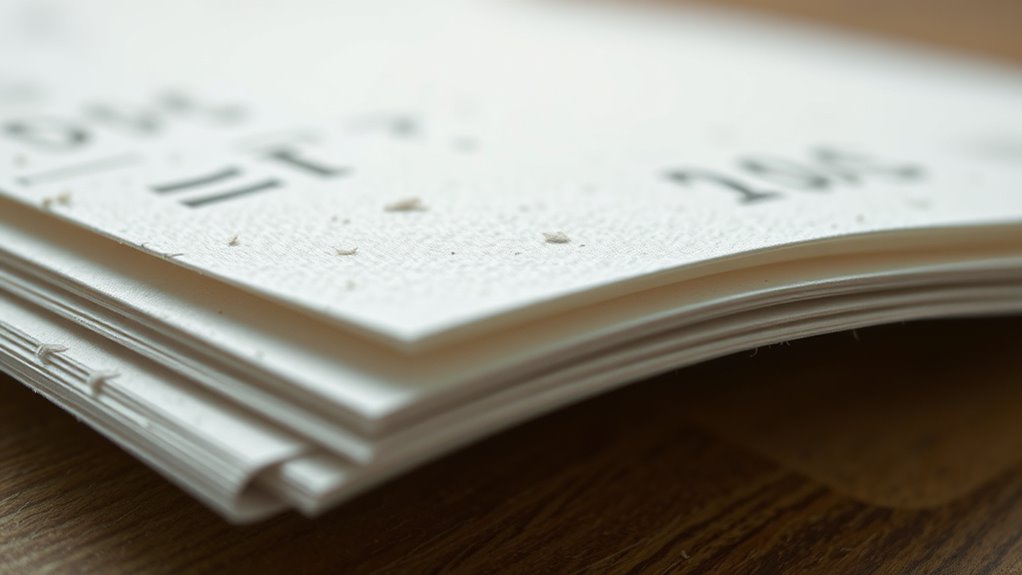
The fibers that make up paper considerably influence its weight and overall quality. Your choice of fiber composition determines how dense and heavy the final product feels. For example, longer, stronger fibers like linen or hemp create a sturdier, heavier paper, while shorter fibers such as wood pulp produce lighter sheets. The impact on weight stems from the fiber’s density and length, affecting how much material is packed into a given area. Additionally, blended fibers can alter the overall weight, offering a balance of durability and lightness. Understanding how fiber composition influences weight helps you select the right paper for your specific needs, whether you require a lightweight sheet for printing or a heavier, more durable material for artistic projects. Fiber properties also play a crucial role in determining the paper’s texture and appearance.
How Density and Thickness Define Paper Texture
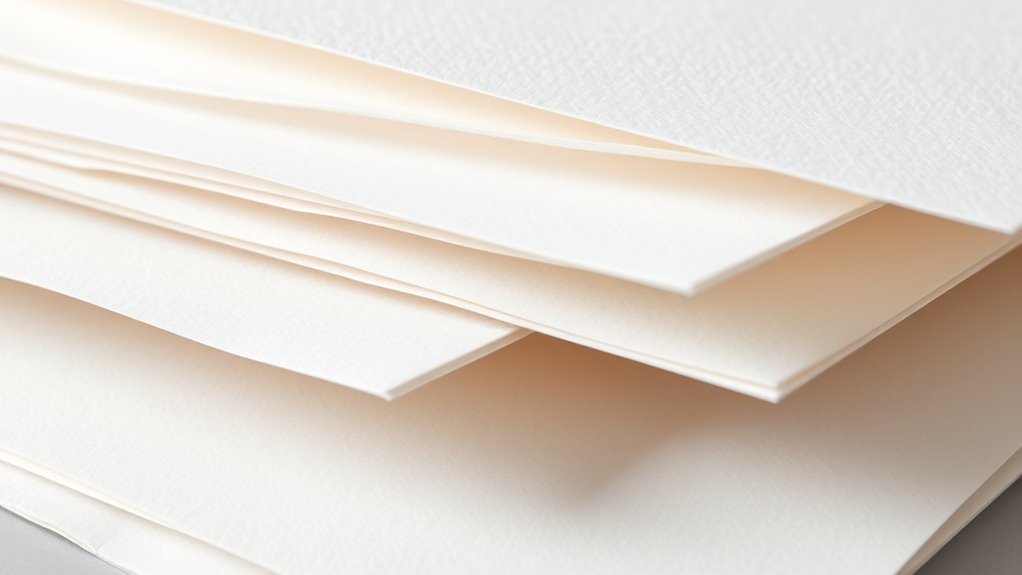
Density and thickness are the key factors that shape the texture of your paper, influencing how it feels to touch and handle. Higher fiber density results in a smoother surface with less surface roughness, giving your paper a sleek, polished feel. Thicker paper, on the other hand, adds to the overall weight and sturdiness, making it feel more substantial. When fiber density is low, the surface becomes rougher, creating a more textured and tactile experience. Conversely, increased density minimizes surface imperfections, producing a finer, more refined texture. Thickness contributes to the perceived quality, affecting how the paper responds during writing or printing. By understanding how fiber density and thickness work together, you can select paper with the ideal texture for your specific needs, whether smooth or textured.
The Role of Manufacturing Processes in Shaping Paper Properties
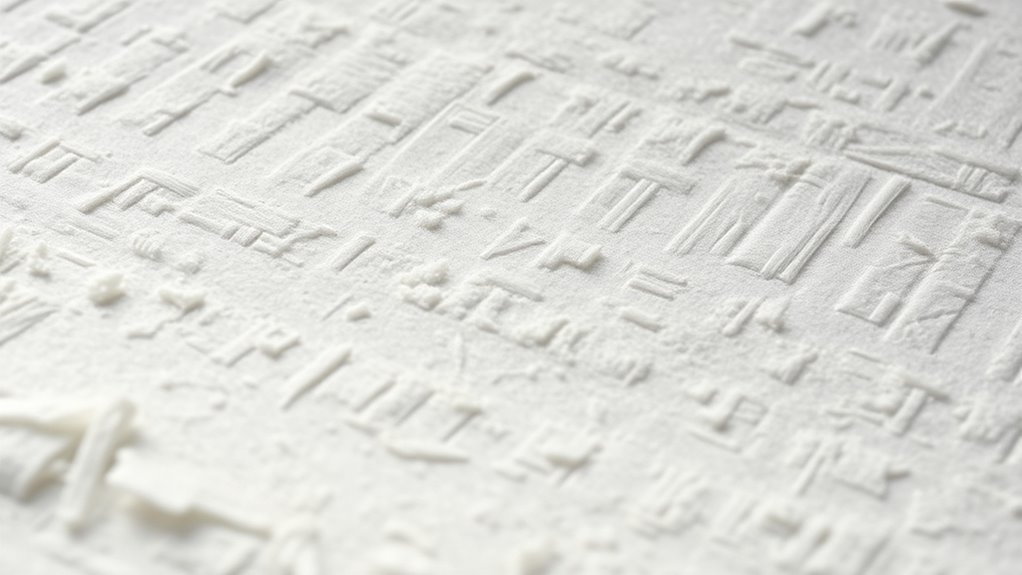
Manufacturing processes directly influence the fiber arrangement, thickness, and surface characteristics of paper. You control these outcomes through techniques like pressing, drying, and calendering, which determine how fibers align and compact. Chemical treatments, such as sizing or fillers, modify surface properties, affecting texture and printability. Environmental factors like humidity and temperature during production also play a essential role, impacting fiber swelling and bonding. These factors collectively shape the final paper’s weight, stiffness, and surface smoothness. Fiber alignment is a critical aspect that determines the overall quality and performance of the final product. By adjusting manufacturing steps and chemical applications, you can tailor paper to specific needs, whether for high-quality printing, packaging, or artistic use. Understanding these processes helps you produce consistent, high-performance paper with desired texture and strength.
Surface Coatings and Their Effect on Texture and Finish
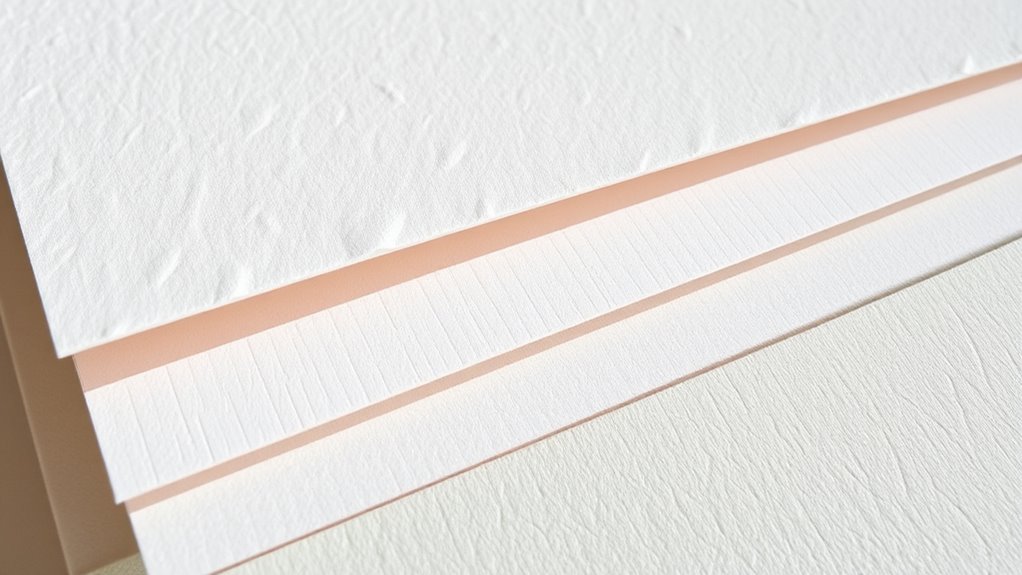
Surface coatings come in various types and textures that can markedly change how your paper feels and looks. The right coating enhances the finish, making it smoother or more matte, depending on your needs. Understanding these options helps you choose the best coating for your project’s desired appearance and tactile quality.
Coating Types and Textures
Have you ever noticed how different coatings can dramatically alter the texture and finish of a paper? Coating types like embossed textures add a tactile dimension, creating raised patterns that make your paper stand out. These textures enhance visual interest and provide a unique feel. Matte coatings, on the other hand, give a smooth, non-reflective surface that feels soft and subdued. They’re popular for printing projects where readability and elegance matter. The choice of coating impacts not just appearance but also how the paper handles ink and light. By selecting the right coating type, you control the final texture, whether it’s a subtle matte finish or a boldly embossed surface. Understanding these options helps you craft paper with the perfect touch and visual effect. Additionally, being aware of resources and tools available can help you choose the best coating for your specific needs.
Finish Appearance and Feel
Ever wondered how the finish appearance and feel of a paper influence its overall impression? The surface coatings you choose profoundly impact texture and aesthetic appeal. Eco friendly materials are gaining popularity, offering sustainable options that don’t compromise quality. These eco-conscious coatings can add subtle gloss or matte finishes, enhancing the paper’s tactile experience. Artistic textures, such as embossed or textured coatings, create unique visual and tactile effects that make your work stand out. The finish not only affects how the paper looks but also how it feels in your hands, influencing perceptions of quality and creativity. When selecting surface coatings, consider how the finish appearance and feel align with your project’s purpose—whether sleek, rough, or richly textured—to leave a memorable impression. Additionally, understanding AI security vulnerabilities can help optimize manufacturing processes and ensure the integrity of the final product.
The Interaction Between Mediums and Paper Surface Properties
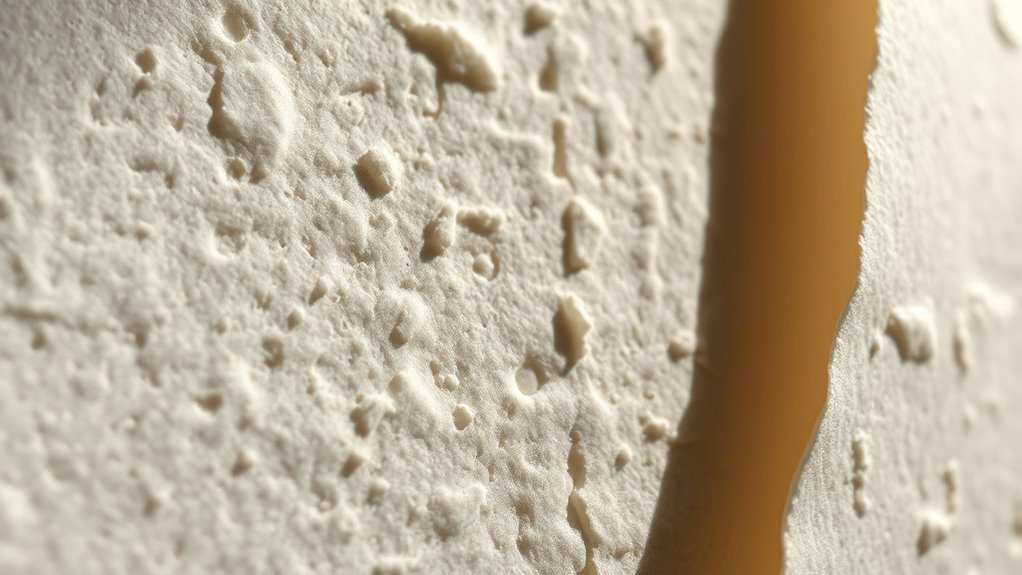
The interaction between mediums and paper surface properties plays a crucial role in determining the quality and appearance of your artwork. When you apply ink or paint, paper fiber elongation influences how the medium spreads and adheres. Papers with higher fiber elongation allow fibers to stretch, providing a smoother surface that enhances ink absorption. This results in sharper lines and richer color tones. Conversely, rough or textured surfaces can cause uneven ink absorption, leading to graininess or blotches. Understanding these interactions helps you choose the right paper for your medium—whether you want crisp details or a more textured finish. Proper surface properties ensure your medium interacts effectively with the paper, ultimately affecting the durability and visual impact of your artwork. Additionally, surface properties can influence how well the paper maintains its integrity over time, contributing to the longevity of your work.
Comparing Light, Medium, and Heavyweight Papers for Different Applications
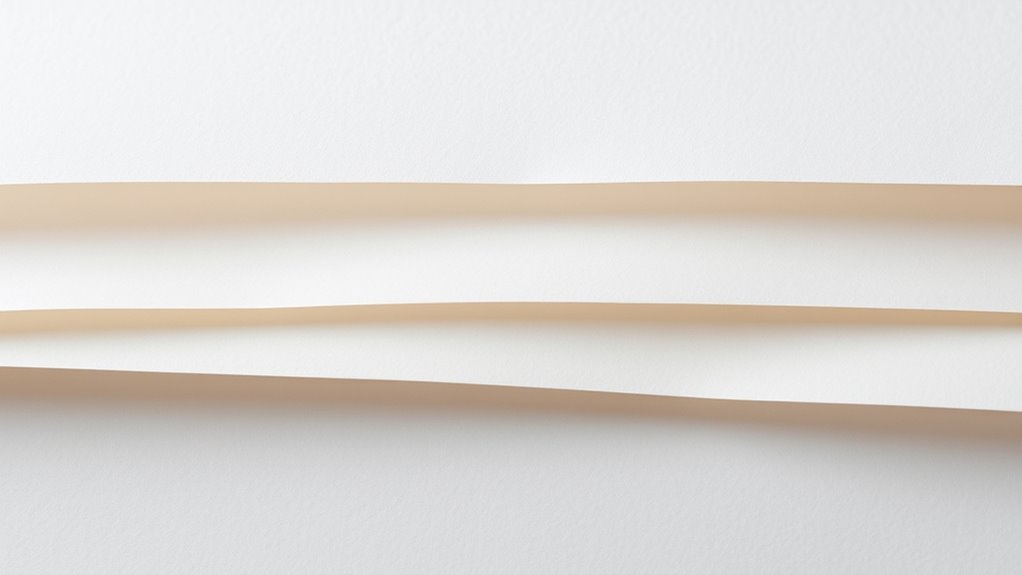
Choosing the right paper weight depends on your printing needs, durability, and visual appeal. Light papers are great for quick printing, while medium and heavyweights offer more strength and texture. Understanding these differences helps you select the best option for your specific application. Additionally, the weight of the paper can influence how well it holds a smooth finish, especially when using different printing techniques.
Suitability for Printing
Have you ever wondered which paper weight suits different printing tasks best? Lightweight papers are ideal for everyday documents like memos and flyers, offering quick drying and smooth printing. Medium weights provide durability for reports, brochures, and marketing materials, ensuring they hold up after handling. Heavyweight papers are perfect for high-end printing, such as business cards and invitations, giving a professional feel. When choosing paper, consider recycling practices; lighter papers often consume less energy during production. Also, think about paper color options—white or off-white can affect text clarity and overall presentation. Using the right weight and texture enhances print quality and guarantees your message stands out. Selecting suitable paper not only improves results but also aligns with sustainable practices. Additionally, selecting the correct asset division strategies can improve the overall quality of your printing projects by ensuring you allocate resources efficiently.
Durability and Handling
Different paper weights handle wear and tear in distinct ways, influencing their suitability for various applications. Lightweights are flexible and easy to handle but can tear or crease easily, making them less ideal for frequent handling or long-term storage. Medium-weight papers strike a balance, offering decent durability for everyday use and easier handling. Heavyweight papers are more resistant to damage, making them perfect for projects that require durability, such as archival storage solutions or professional presentations. When choosing paper for specific needs, consider how well it withstands handling and wear over time. Heavier papers often have a lower environmental impact regarding longevity, reducing the need for frequent replacement. Overall, matching paper weight to your handling demands ensures better performance and sustainability.
Visual and Textural Appeal
When evaluating paper for its visual and textural appeal, the weight markedly influences how it looks and feels. Lighter papers often have a delicate, airy quality, enhancing color vibrancy for designs that require brightness and subtlety. Medium-weight papers strike a balance, offering a satisfying tactile sensation without feeling bulky, making them versatile for various applications like brochures or letters. Heavyweight papers provide substantial tactile feedback, giving a premium feel and enhancing color depth, especially for cover pages or high-end print work. The tactile sensation varies from smooth and sleek in lighter options to textured and sturdy in heavier grades. Your choice impacts not just the visual appeal but also how engaging the paper feels, influencing the overall perception of your project.
Innovations in Paper Technology and Their Influence on Material Characteristics
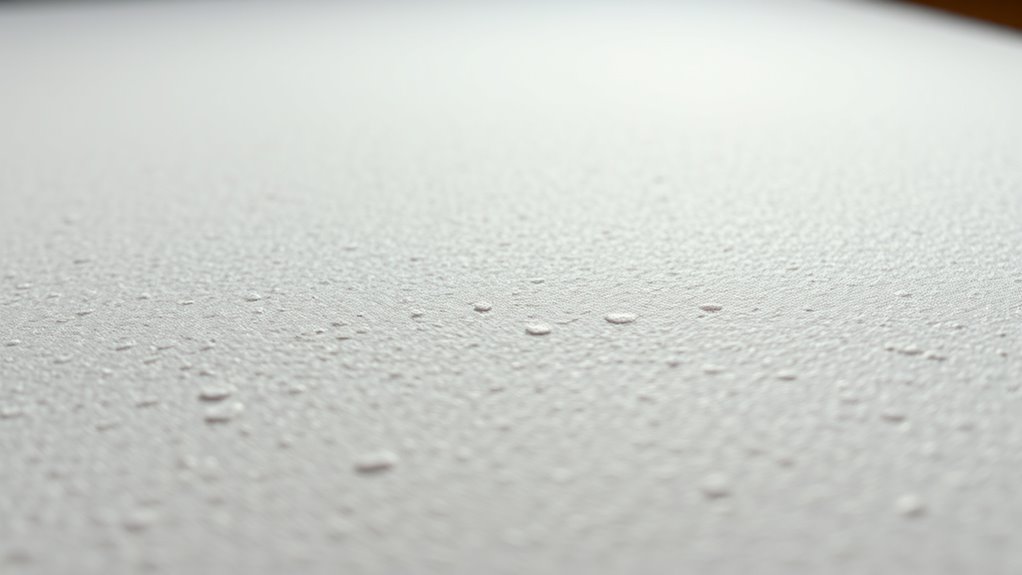
Recent advancements in paper technology have substantially transformed the way materials are produced and utilized. Eco friendly alternatives, such as recycled fibers and plant-based materials, now reduce environmental impact without compromising quality. Digital printing innovations enable sharper images and faster production, influencing how you choose paper for projects. These technologies also improve texture and durability, making paper more adaptable to various uses. Additionally, understanding merchant services can help businesses select the most suitable options for their needs.
Frequently Asked Questions
How Does Paper Weight Influence Printing Quality and Ink Absorption?
You’ll notice that paper weight impacts printing quality and ink absorption considerably. Thicker paper, with greater paper thickness, provides a smoother surface, reducing ink penetration and preventing smudging. Conversely, thinner paper absorbs ink more quickly, which can cause bleed and less sharp images. Choosing the right paper weight guarantees your printouts look crisp and professional, as it balances ink absorption and surface durability for ideal results.
What Environmental Factors Affect the Texture and Durability of Paper?
They say “a stitch in time saves nine,” and the same applies to paper’s durability. You’ll notice that humidity effects can make paper warp or weaken, while manufacturing pollutants can degrade its texture over time. Exposure to moisture and pollutants accelerates wear, reducing lifespan. To keep your paper in top condition, store it in a dry, clean environment, protecting it from elements that compromise its texture and durability.
Can Paper Weight and Texture Impact Archival Longevity?
Your choice of paper weight and texture can substantially impact archival longevity. Heavier, acid-free paper with a smooth texture helps preserve cellulose and reduces deterioration over time. Acidic paper accelerates decay, harming cellulose preservation. By selecting high-quality, acid-free, textured paper, you guarantee your documents last longer, maintaining their integrity and readability for future generations. Proper paper selection is essential for effective archival preservation.
How Do Different Dyes and Inks Interact With Various Paper Textures?
You notice that different dyes and inks react uniquely with various paper textures. When you apply dye, absorption varies depending on the surface, affecting how vibrant or dull the color appears. Ink bleed can occur more easily on rough or porous textures, causing blurry edges. Smooth, coated papers tend to minimize ink bleed and promote sharper images, making your choices essential for desired results and longevity in archival or artistic applications.
Are There Health Considerations Related to Manufacturing Textured or Heavy-Weight Paper?
You might think textured or heavy-weight paper is just fancy, but in reality, manufacturing can pose health risks. While it’s tempting to ignore it, occupational safety is essential, and chemical exposure during production isn’t always obvious. Workers face potential hazards from dyes, inks, and chemicals used in creating these papers. So, yes, there are health considerations, and it’s wise to prioritize safety measures to minimize risks.
Conclusion
Now that you understand how paper weight and texture are measured and influenced, you’ll see why choosing the right paper matters. Did you know that the global paper industry produces over 400 million tons annually? That’s enough to fill a thousand Olympic-sized pools each year! By considering weight, texture, and coatings, you can select the perfect paper for your project, ensuring quality and durability every time.
